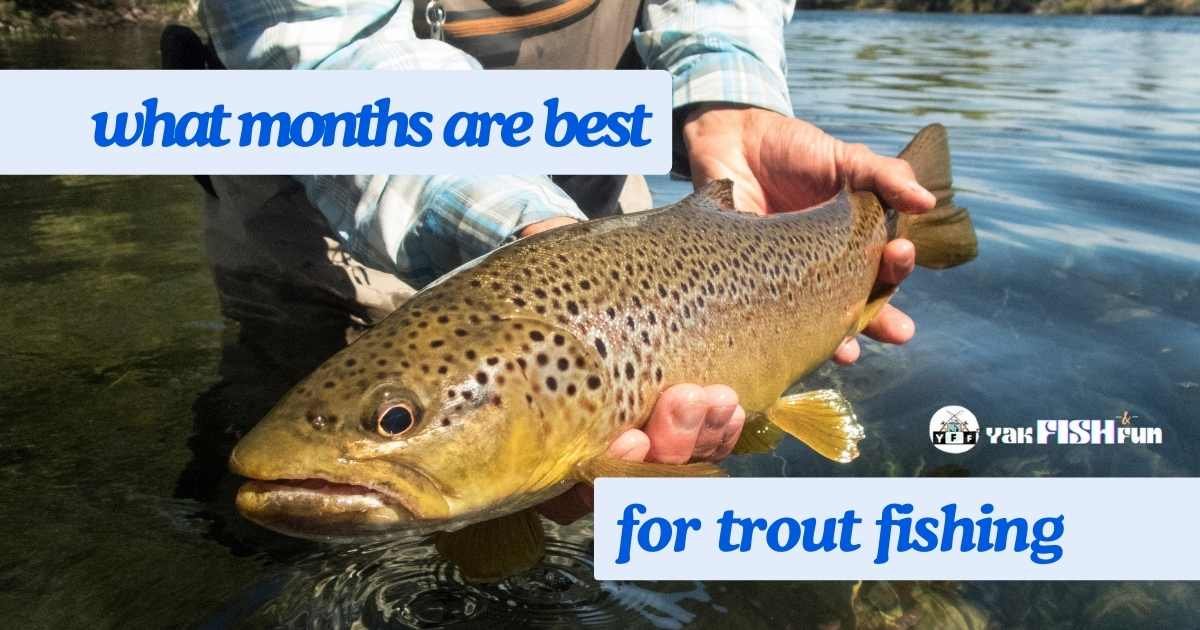Timing can be everything when it comes to trout fishing, as these fish are influenced by seasonal changes in their environment. Understanding the best months for trout fishing can help you plan your trips more effectively and increase your chances of success. But what months are best for trout?
April through June and September through October are the best months for trout fishing. These periods offer optimal weather and water conditions.
During April through June, melting snow increases water flow, making it perfect for trout. September through October, cooler temperatures and less crowded waters improve the chances of a successful catch.
So, planning a trip during these peak times can maximize your chances of reeling in a big catch.
In this post, we will explore the prime times of the year for catching trout, considering factors such as water temperature, trout behavior, and local conditions.
Table of Contents

Understand The Trout Fishing Seasons – When To Get The Best Bite
Spring and fall offer the best trout fishing experiences. These months provide ideal water temperatures and active feeding patterns. Early morning and late afternoon during these seasons yield the highest success rates.
Trout fishing enthusiasts know that timing is everything. Understanding the best months for trout fishing can make all the difference in your catch rate. Seasons play a critical role in trout behavior and feeding patterns. Here’s a detailed look at when to target trout for optimal success.
Early Spring (March to April)
Early spring is a prime time for trout fishing. As the ice melts and water temperatures rise, trout become more active.
- Water temperatures: Ideal conditions for trout activity.
- Insect hatch: Increased food availability.
- Less fishing pressure: Fewer anglers mean more opportunities.
Late Spring (May To June)
In late spring, trout are feeding heavily to regain energy after winter. This period offers some of the best fishing opportunities.
Trout are particularly active during this time, making late spring a favorite for many anglers. The abundance of insects and moderate temperatures contribute to a successful fishing experience.
Summer (July to August)
Summer trout fishing can be challenging but rewarding. Trout seek cooler, deeper waters during the heat of summer.
- Early mornings and late evenings: Cooler temperatures make trout more active.
- Deeper waters: Trout moves to cooler depths.
- Fly fishing: Ideal for matching the summer insect hatch.
Fall (September to October)
Fall is another excellent season for trout fishing. As temperatures drop, trout become more aggressive in their feeding.
During fall, trout are preparing for winter, making them more likely to bite. The beautiful autumn scenery adds to the allure of fall trout fishing.
Winter (November to February)
Winter trout fishing is less popular but can be incredibly rewarding for the persistent angler.
- Ice fishing: A unique and exciting way to catch trout.
- Slower metabolism: Trout feed less but are still catchable.
- Solitude: Fewer anglers on the water.
Understanding the different trout fishing seasons helps in planning your trips for the best results. Each season offers unique challenges and rewards, making trout fishing an engaging year-round pursuit.
How Weather Impacts Trout Fishing
Spring and fall offer the prime conditions for trout fishing, with mild temperatures and active trout. Summer heat often drives trout to deeper, cooler waters. Early mornings and late evenings during these months yield the best results.
Trout fishing enthusiasts know that weather plays a crucial role in their success. Understanding how different conditions affect trout can make or break your fishing trip. Here, we delve into the impact of weather on trout fishing.
Temperature And Its Effects
Temperature significantly influences trout behavior. Here’s a look at how temperature changes can impact your fishing experience:
- Cold Weather: Trout are less active and feed less.
- Warm Weather: Trout seek deeper, cooler waters.
- Optimal Temperature: Trout are most active between 50°F and 60°F.
Barometric Pressure Changes
Barometric pressure shifts can alter trout feeding habits. Let’s explore these effects through some key points:
- Rising Pressure: Trout feed more as it usually signals good weather.
- Falling Pressure: Trout often becomes less active.
- Stable Pressure: Consistent feeding patterns, making it ideal for fishing.
Wind Conditions
Wind can either aid or hinder your fishing adventure. Various wind conditions have different effects on trout behavior:
- Light Winds: Stimulate surface feeding.
- Strong Winds: Make casting difficult and can scatter fish.
- Wind Direction: Certain directions can bring in food sources, enhancing feeding.
Cloud Cover And Sunlight
The amount of sunlight and cloud cover can impact trout visibility and feeding:
- Bright Sunlight: Trout seek shaded or deeper areas.
- Overcast Skies: Trout are more likely to roam and feed.
- Partly Cloudy: Offers a balance, with trout feeding both at the surface and below.
Rain And Its Impact
Rain can influence trout activity in several ways. The following points highlight its effect:
- Light Rain: Increases oxygen levels, making trout more active.
- Heavy Rain: Can muddy waters, making it harder for trout to see bait.
- Post-Rain: Often a prime time for feeding due to washed-in food sources.
Seasonal Considerations
Different seasons bring varied weather patterns, each affecting trout differently:
- Spring: Increased insect activity, boosting trout feeding.
- Summer: Higher temperatures drive trout to deeper waters.
- Fall: Cooling temperatures and spawning season increase feeding activity.
- Winter: Cold waters slow down trout metabolism and activity.
Understanding these weather patterns can help you plan your trout fishing trips more effectively. Keep an eye on the forecast and adapt your techniques accordingly.
Best Months For Trout Fishing In Different States
Spring and early summer offer the best trout fishing months in most states. April through June are ideal in Colorado, while California sees peak activity from May to July.
The thrill of trout fishing varies by location and time of year. Understanding the best months for trout fishing in different states can enhance your fishing experience. Here, we break down the prime times for several states.
Colorado
Colorado offers fantastic trout fishing opportunities throughout the year. However, certain months stand out.
- April to June: Springtime sees melting snow, increasing river flow, and active trout.
- September to October: Fall provides cooler temperatures and fewer anglers, making it an ideal time.
California
California’s diverse waters provide year-round trout fishing, but some months are particularly fruitful.
From the Sierra Nevada to the coastal streams, the best months are:
- March to May: Spring melt-off leads to clear, cold water perfect for trout.
- October to November: Fall provides cooler weather and active trout before winter sets in.
Montana
Montana, known for its pristine rivers and lakes, offers some of the best trout fishing in the country.
- June to August: Summer months offer warm weather and abundant insect hatches.
- September: Early fall brings cooler temperatures and fewer tourists, perfect for fishing.
Pennsylvania
Pennsylvania’s rich fishing heritage provides excellent opportunities for trout anglers.
- April to June: Spring is prime time with stocked streams and active trout.
- September to October: Fall brings cooler waters and less crowded streams.
Michigan
Michigan’s Great Lakes and inland streams are a haven for trout fishing enthusiasts.
During these months, trout fishing peaks:
- May to June: Springtime offers ideal water conditions and active fish.
- September: Cooler fall temperatures make trout more active and easier to catch.
New York
New York’s diverse waterways offer excellent trout fishing year-round, but some periods are better.
- April to June: Spring provides optimal conditions with stocked streams and rising temperatures.
- September to October: Fall offers cooler weather and less competition, ideal for a peaceful fishing trip.
North Carolina
North Carolina’s mountain streams and rivers are popular trout fishing spots.
- March to May: Spring months offer clear waters and active trout.
- October to November: Fall provides cooler temperatures and vibrant foliage, enhancing the fishing experience.
Oregon
Oregon’s varied landscape offers excellent trout fishing opportunities throughout the year.
- April to June: Springtime means melting snow and rising water levels, perfect for trout.
- September to October: Fall offers cooler weather and fewer anglers, ideal for a quiet fishing trip.
Understanding the best months for trout fishing in different states can significantly improve your chances of a successful catch. Happy fishing!
Best Seasons For Different Trout Species
Spring and fall are ideal for catching rainbow trout, while brown trout thrive in the summer months. Winter offers excellent opportunities for targeting brook trout in colder waters.
Trout fishing enthusiasts eagerly anticipate the best times to catch specific trout species. Each season brings unique opportunities for anglers to reel in their desired catch. Understanding these seasonal patterns can significantly enhance your fishing experience.
Spring: Rainbow Trout
Spring is an excellent time for targeting rainbow trout. As the water warms, these trout become more active.
- Spawning Season: Spring marks the spawning period for rainbows, making them more aggressive.
- Increased Activity: Warmer temperatures lead to increased feeding activity.
- Shallow Waters: Rainbows move to shallower waters, making them easier to catch.
Summer: Brown Trout
Brown trout thrive in summer. The warmer months offer ideal conditions for catching this elusive species.
- Evening Bites: Browns are more active in the late evening.
- Cooler Waters: Seek them in cooler, deeper waters.
- Insect Abundance: Increased insect activity provides ample food sources.
Fall: Brook Trout
Fall is perfect for brook trout fishing. The cooler weather and changing leaves make for a picturesque fishing experience.
Brook trout are most active during the autumn months. They prepare for winter and become more aggressive.
- Spawning Season: Fall marks the brook trout’s spawning period.
- Vibrant Colors: Their colors are most vibrant in fall.
- Cooler Temperatures: Cooler waters make them more comfortable and active.
Winter: Lake Trout
Winter months bring prime opportunities for lake trout fishing. Cold temperatures suit their preferences.
- Deep Waters: Lake trout dwells in the deepest, coldest parts of lakes.
- Ice Fishing: Winter ice fishing offers unique challenges and rewards.
- Slow Metabolism: Lake trout feed less but are still catchable with patience.
Each season presents unique opportunities for different trout species. Knowing when and where to fish can make your trout fishing adventures more successful and enjoyable.
When To Go Trout Fishing For The Best Results?
Spring and fall are prime months for trout fishing, offering optimal water temperatures and active fish. During April to June and September to October, trout are more likely to bite, making these months ideal for anglers seeking the best results.
Fishing for trout can be rewarding if you pick the right months. The timing affects the trout’s feeding patterns and activity levels. Knowing when to fish can significantly enhance your chances of success.
Early Spring (March to April)
Early spring offers prime trout fishing opportunities. As the water begins to warm up, trout become more active. Here are some key points to consider:
- Water Temperature: Warmer water encourages trout to feed more actively.
- Insect Hatches: Increased insect activity means more food for trout, making them easier to catch.
- Less Competition: Fewer anglers on the water, offering you a quieter experience.
Late Spring To Early Summer (May To June)
Late spring and early summer also provide excellent fishing conditions. Here’s why:
- Stable Weather: More predictable weather patterns make planning your fishing trips easier.
- Longer Days: Extended daylight hours give you more time to fish.
- Diverse Food Sources: A variety of insects and small fish are available, attracting more trout.
Mid To Late Summer (July to August)
Mid to late summer can be trickier but still rewarding. Consider the following factors:
- Cooler Mornings: Early mornings offer cooler water temperatures, making trout more active.
- Deep Waters: Trout tends to move to deeper, cooler waters, so adjust your fishing techniques accordingly.
- Peak Feeding Times: Focus on early morning and late evening when trout are most active.
Early Fall (September to October)
Early fall is another great period for trout fishing. Here’s why:
- Cooling Waters: As temperatures drop, trout become more active again.
- Less Crowded: Fewer anglers are out, providing a more peaceful experience.
- Fall Spawning: Some trout species spawn in the fall, making them more aggressive and easier to catch.
Late Fall To Early Winter (November to December)
Late fall to early winter can be challenging but rewarding. Key points include:
- Cold Water: Trout remains active in colder water, especially in streams and rivers.
- Fewer Insects: Less insect activity means trout are more likely to bite at artificial lures.
- Quiet Waters: Very few anglers brave the cold, giving you more solitude.
Choosing the right months for trout fishing can make a significant difference. Each season offers unique opportunities and challenges.
Tips And Tricks To Maximize Trout Fishing
Spring and fall offer the best months for trout fishing. During these times, trout are more active and easier to catch. Cooler water temperatures in these seasons create ideal conditions for successful fishing trips.
Trout fishing can be an exhilarating experience, especially when you know the best months to cast your line. To make the most of your time on the water, it’s essential to use effective strategies. Here are some tips and tricks that can help you maximize your trout fishing success.
Understand Seasonal Behavior
Trout behavior varies with the seasons. Knowing these patterns can significantly improve your catch rate.
- Spring: Trout are more active as the water warms up. Look for them in shallow areas.
- Summer: They often retreat to deeper, cooler waters. Early mornings and late evenings are prime times.
- Fall: Trout feed aggressively to prepare for winter. Focus on areas with abundant food sources.
- Winter: They become sluggish and stay in deeper, warmer waters. Use smaller baits and fish slowly.
Use The Right Gear
Having the proper equipment can make a huge difference. Here’s a quick guide to essential gear:
- Rods and Reels: Use a light to medium-light rod for better sensitivity.
- Fishing Line: Opt for a 4 to 6-pound test line to avoid scaring the fish.
- Bait and Lures: Live bait like worms or artificial lures that mimic local prey work best.
Choose The Perfect Spot
Location is key in trout fishing. Knowing where to cast can significantly increase your chances of success.
- Rivers and Streams: Trout often hide near rocks and in shaded areas.
- Lakes: Look for drop-offs and underwater structures.
- Tailwaters: These areas below dams are rich in oxygen and attract trout.
Master Casting Techniques
Effective casting can get your bait where the trout are hiding. Here are some tips:
- Short Casts: Ideal for small streams and rivers.
- Long Casts: Necessary for larger lakes and reservoirs.
- Accurate Casting: Practice to ensure your bait lands softly and naturally.
Monitor Weather Conditions
Weather plays a crucial role in trout activity. Adjust your fishing strategy based on the conditions.
- Cloudy Days: Trout are more likely to be near the surface.
- Sunny Days: They tend to stay deeper and seek shade.
- Rainy Conditions: Light rain can stimulate feeding activity.
Bottom Line
Knowing the best months for trout fishing can boost your success and enjoyment. By understanding seasonal patterns, water temperatures, and trout behavior, you can plan your trips for peak trout activity. Each season offers unique opportunities: spring’s vibrant activity, summer’s consistent action, fall’s feeding frenzy, and winter’s unique challenges. With this knowledge, you’re ready to make the most of your trout fishing all year round. So, mark your calendar, gather your gear, and get ready to enjoy the best trout fishing seasons.


